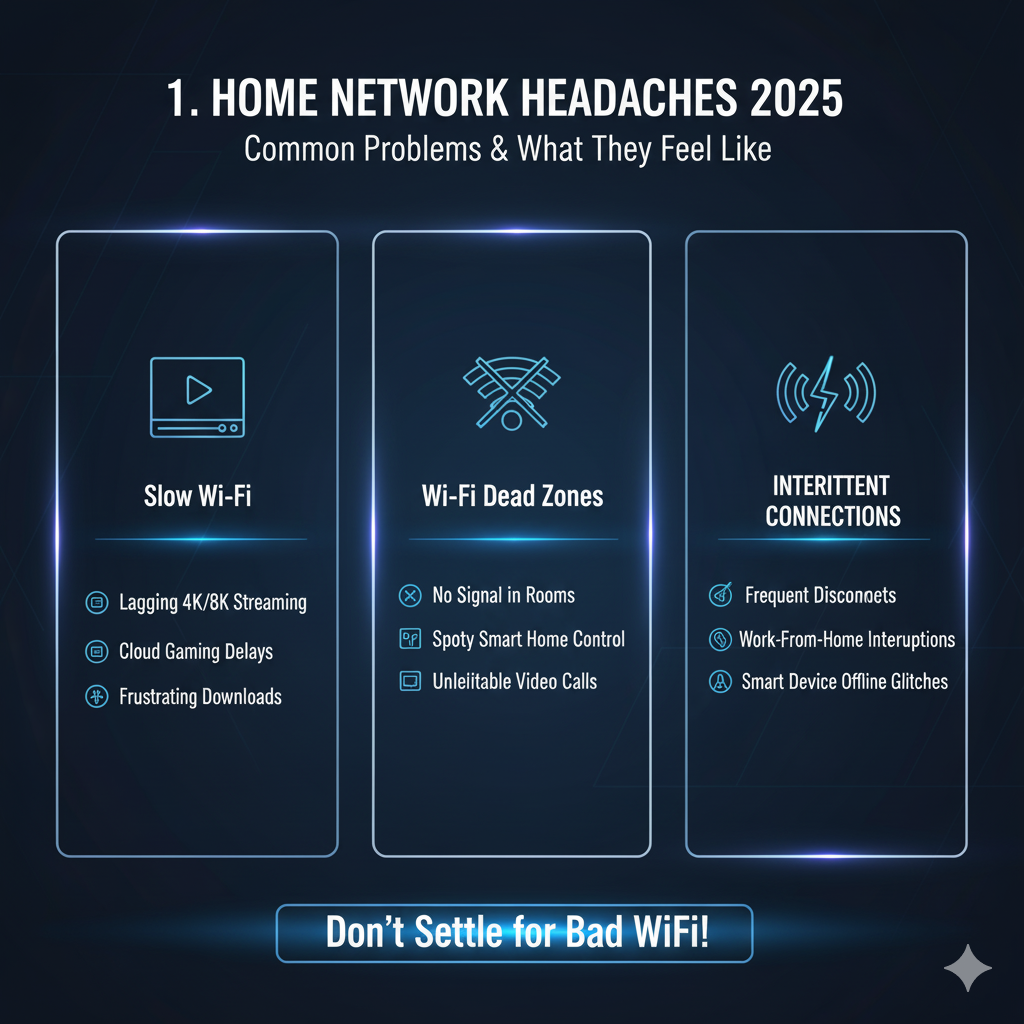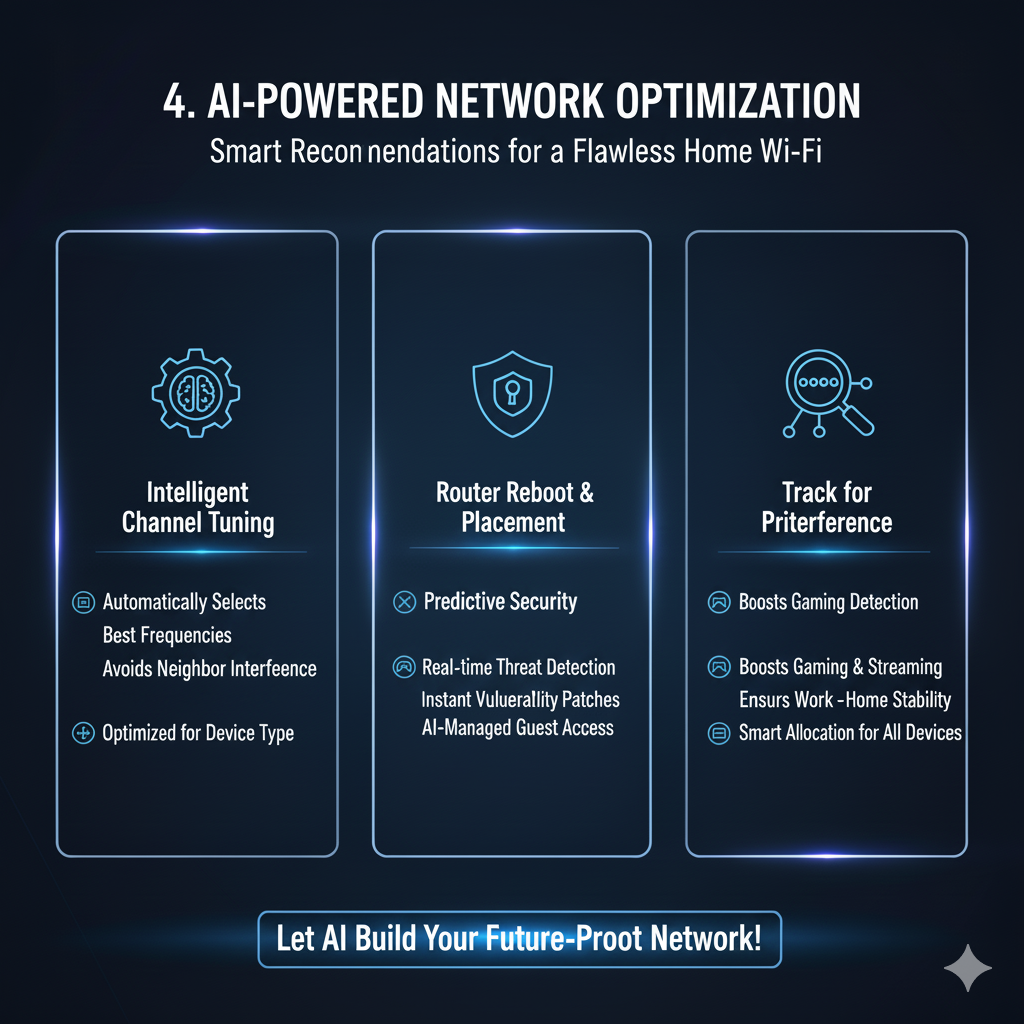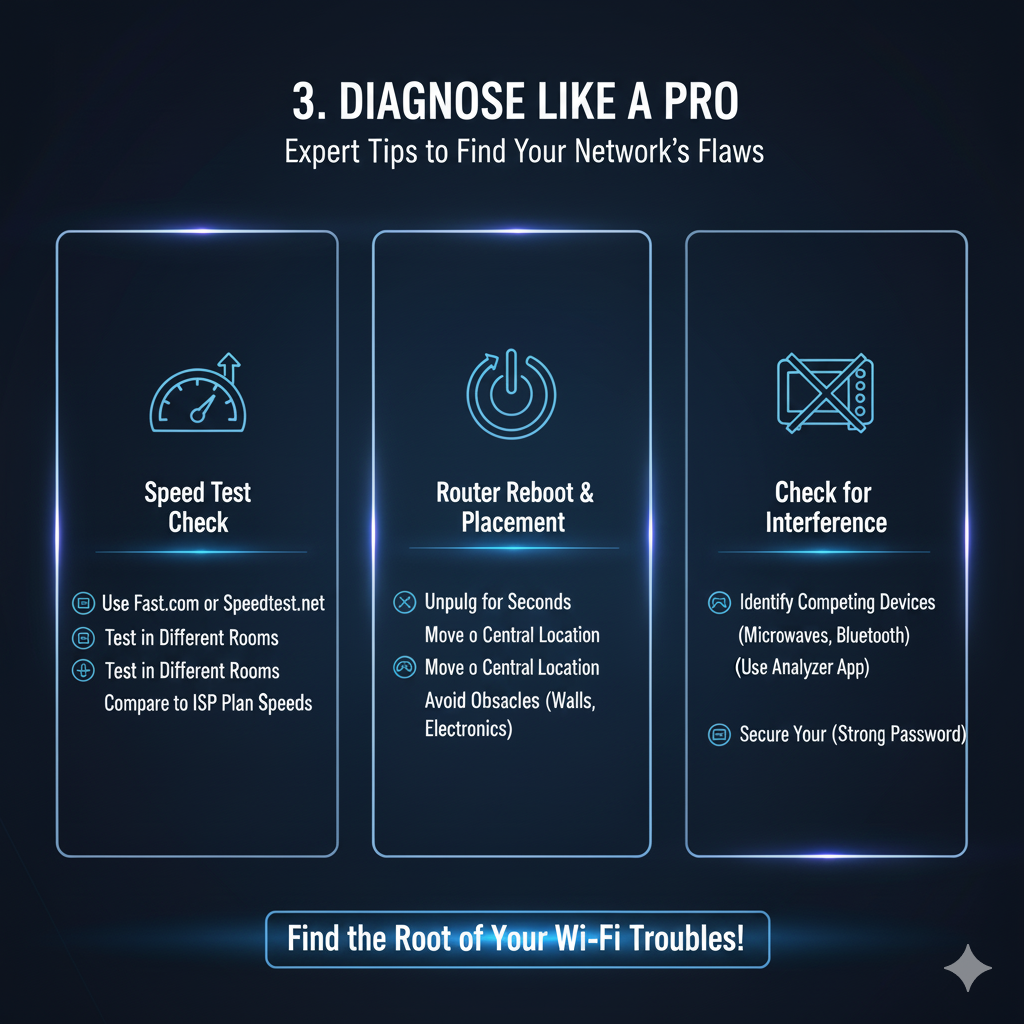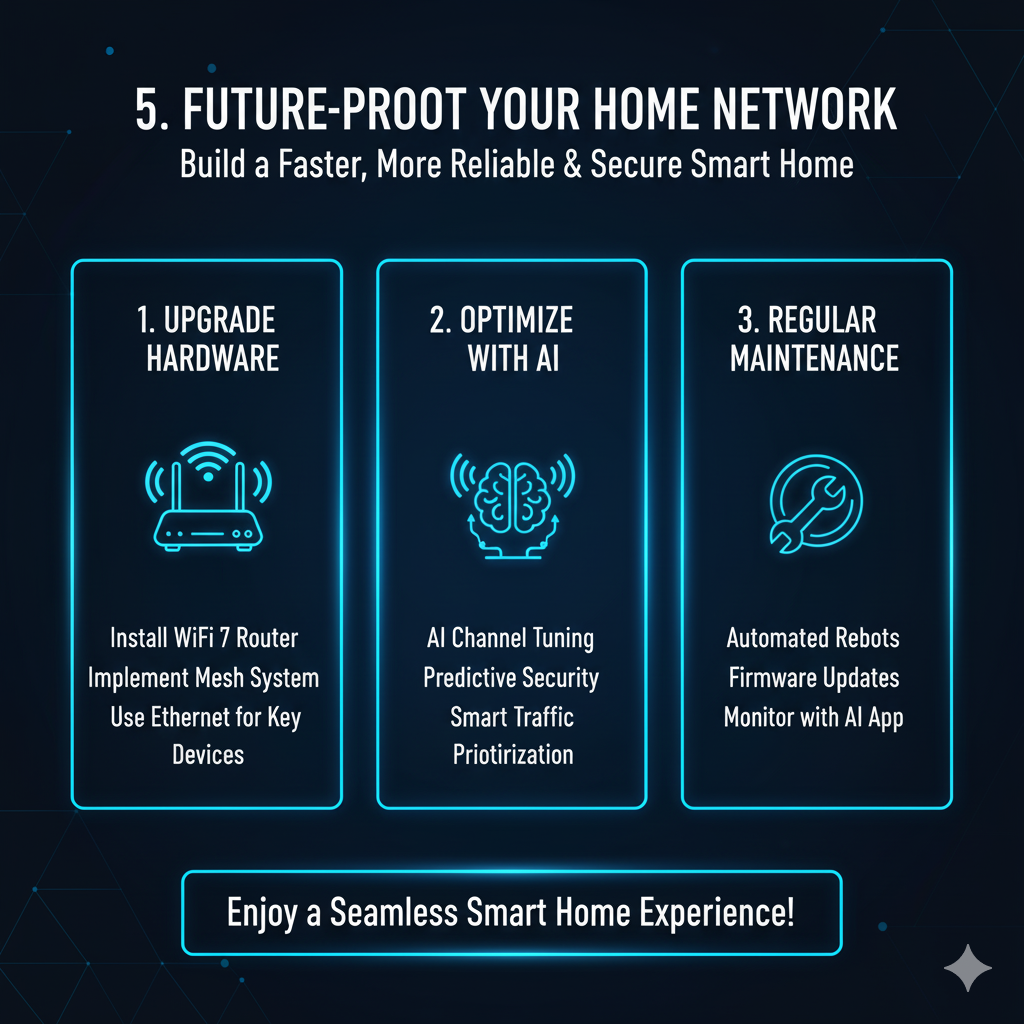
In today’s hyper-connected world, a reliable home network is no longer a luxury
—it’s the backbone of our digital lives.
From remote work and online learning to streaming 4K entertainment and managing a growing ecosystem of smart home devices, our networks are under more strain than ever before.
As we venture further into 2025, the demands on our home networks will only intensify,
making it crucial to understand how to troubleshoot common problems and leverage the latest technologies to stay ahead of the curve.
This guide will walk you through the most frequent home network issues, explore the cutting-edge solutions available in 2025,
and introduce the transformative role of artificial intelligence (AI) in creating a truly intelligent and self-healing home network.

The Unseen Importance of a Robust Home Network
We often take our home network for granted, only noticing it when something goes wrong.
But behind the scenes, it’s the unsung hero that powers our modern lifestyles.
A strong and stable home network is the foundation for:
Productivity: For the millions who work or study from home, a reliable internet connection is non-negotiable.
Video conferences, cloud-based collaboration, and access to online resources all depend on a network that can handle the load.
Entertainment: From streaming the latest blockbuster in 4K to immersive online gaming, our entertainment experiences are increasingly data-intensive.
A powerful home network ensures a smooth and buffer-free experience.
The Smart Home: The promise of the smart home
—a seamless and automated living experience
—can only be realized with a network that can support a multitude of connected devices,
from smart speakers and security cameras to thermostats and lighting.
Communication: Staying connected with loved ones through video calls, social media, and messaging apps is more important than ever.
A reliable network ensures that these connections are clear and uninterrupted.
The State of Home Networking in 2025
The home network of 2025 is a far cry from the simple setups of the past. Several key trends are shaping this evolution:
The Rise of Wi-Fi 7: The latest Wi-Fi standard, Wi-Fi 7 (802.11be), is a game-changer, offering significantly faster speeds,
lower latency, and the ability to handle a massive number of devices simultaneously.
This is essential for the modern smart home, where everything from your refrigerator to your lightbulbs is connected to the internet.

The AI-Powered Network: Artificial intelligence is no longer just a buzzword; it’s becoming the brain of the modern home network.
AI-powered routers and services can now proactively monitor your network, diagnose problems, and even fix them automatically, often before you even notice an issue.
The Smart Home Hub: The humble home router has evolved into a powerful smart home hub, capable of managing all your connected devices and ensuring they work together seamlessly.
This is especially important with the growing adoption of the Matter standard, which aims to create a unified ecosystem for smart home devices.
Common Home Network Problems and How to Fix Them
Even with the latest technology, home networks can still run into problems. Here are some of the most common issues and how to address them:
1. Slow Wi-Fi and Network Congestion
The Problem: Your internet feels sluggish, videos buffer endlessly, and downloads take forever.
This is often due to network congestion, with too many devices competing for bandwidth, or outdated hardware that can’t keep up with your internet plan.
The Solution:
Upgrade to a Wi-Fi 7 Router: A Wi-Fi 7 router can provide a significant speed boost and better handle the demands of a device-heavy household.

Consider a Mesh Wi-Fi System: If you have a large home, a mesh Wi-Fi system can provide consistent coverage and reduce congestion by distributing the network load across multiple nodes.
Leverage AI-Powered Quality of Service (QoS):
Many modern routers use AI to automatically prioritize traffic for important activities like video calls or online gaming,
ensuring a smooth experience even when the network is busy.
2. Wi-Fi Dead Zones
The Problem: You have areas in your home where the Wi-Fi signal is weak or non-existent, creating frustrating dead zones.
The Solution:
Optimize Router Placement: The simplest solution is often the most effective. Place your router in a central location, away from walls and other obstructions, to maximize its signal range.
Install a Mesh Wi-Fi System: Mesh systems are the most effective way to eliminate dead zones in larger homes, creating a seamless and powerful Wi-Fi network that covers every corner of your house.
3. Intermittent Connections
The Problem: Your internet connection drops randomly, forcing you to constantly reboot your router or reconnect your devices.
The Solution:
Check Your Hardware: Overheating routers, loose cables, or outdated firmware can all cause intermittent connections.
Make sure your router has proper ventilation, check all your cable connections, and ensure your router’s firmware is up to date.

Use an AI-Powered Troubleshooting Tool: Many ISPs and router manufacturers now offer AI-powered apps that can diagnose and fix connectivity issues automatically.
These tools can identify the root cause of the problem and guide you through the necessary steps to resolve it.
The Future is AI: How Artificial Intelligence is Revolutionizing Home Networking
The most significant advancement in home networking in 2025 is the integration of artificial intelligence.
AI is transforming how we manage and troubleshoot our networks, making them more intelligent, reliable, and secure.
Proactive Problem Solving: AI-powered networks can identify and resolve issues before they impact your online experience.
By analyzing network patterns and performance data, AI can predict potential problems and take corrective action, such as rerouting traffic or adjusting settings to optimize performance.
Automated Troubleshooting: When a problem does occur, AI can quickly diagnose the root cause and provide step-by-step instructions to fix it.
This eliminates the guesswork and frustration of manual troubleshooting, empowering even non-technical users to resolve common network issues.
Enhanced Security: AI plays a crucial role in protecting your home network from cyber threats.
By constantly monitoring for suspicious activity,
AI can detect and block malware, phishing attempts, and other security risks in real-time, keeping your data and devices safe.

Building Your 2025-Ready Home Network
As our lives become increasingly digital, a robust and reliable home network is more important than ever.
By embracing the latest technologies like Wi-Fi 7 and AI-powered troubleshooting, you can build a home network that’s ready for the challenges and opportunities of 2025 and beyond.
Whether you’re a tech-savvy enthusiast or a casual user, the tools and technologies are now available to create a home network that’s faster, more reliable, and more secure than ever before.
So, take the time to assess your current setup, identify any pain points, and explore the exciting new solutions that can help you unlock the full potential of your digital life.
A Step-by-Step Guide to a Better Network:
1. Assess Your Needs: Take stock of how you use your home network. How many devices are connected?
What are your primary online activities?
This will help you determine the right solutions for your specific needs.
2. Evaluate Your Current Setup: Is your router more than a few years old?
Are you experiencing any of the common problems described in this guide? Identifying the weaknesses in your current setup is the first step to improving it.
3. Explore Modern Solutions: Research the latest Wi-Fi 7 routers and mesh Wi-Fi systems to find the best fit for your home and budget.
Look for features like AI-powered QoS and automated troubleshooting.
4. Secure Your Network: Don’t overlook the importance of security. Choose a router with robust security features and consider using a VPN for an extra layer of protection.
5. Embrace AI: Look for opportunities to leverage AI to your advantage.
Whether it’s through an AI-powered router or a dedicated network monitoring service, AI can help you build a smarter, more reliable home network.
By following these steps, you can create a home network that not only meets your current needs but is also ready for the exciting possibilities of the future.
A fast, reliable, and secure home network is the foundation of a truly connected life, and with the right tools and technologies, it’s within everyone’s reach.
